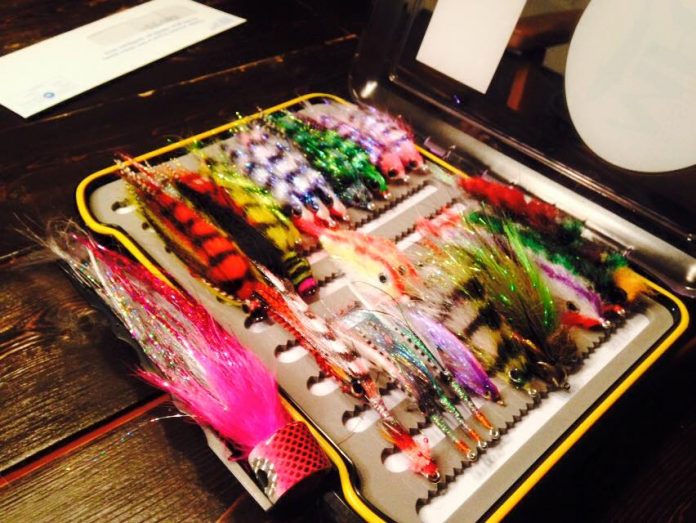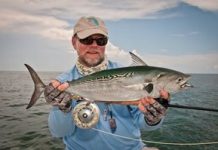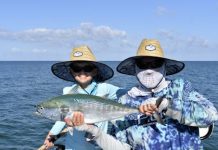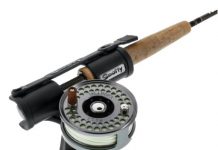A series by Captain Jon Bull
In this installment in the series, Learning to Fly, we get down to business and start deciding what kind of flies we are going to put in front of the fish we hope, will want to eat.
The basic principle, in any kind of fly-fishing that an angler should follow is “match the hatch.” In saltwater fly-fishing, that basically means observing what kind of bait is prevalent, and then throwing a fly that looks like that bait. The time of year can greatly determine the kind of flies that snook, redfish, and trout will eat. During the Spring and Fall, on either coasts of Florida, massive amounts of baitfish funnel in and out of the estuary systems that line the state. Obviously, during this period, larger baitfish imitating flies would be most productive. Topwater flies, which produce exciting surface explosions, are great fun during these baitfish runs. During the Winter, the size of the bait, that fish consume, become smaller to coincide with their slower rate of metabolism. Here, glass minnow patterns and crustacean patterns take over. During the Winter, the saying “down and brown” is a good one to follow. Natural colored, weighted fly patterns best imitate crabs, shrimp, and killifish; which are the staple diet for snook, reds, and trout during the winter.
For someone getting started, going to a fly shop and choosing a basic variety of inshore fly patterns can be a bit overwhelming. A good fly shop will have someone on staff that will be able to help you choose some patterns based on what is going on in the area. I like to base my fly selection on a two schools of thought; search flies and sight flies. Search flies are flies that I would blind cast in hopes of intercepting the path of a fish. A sight fly would be a fly that I would throw after a single fish, or school of fish, has been sighted. Most sight baits are going to be weighted shrimp or crab patterns. However, some search flies can be used as sight flies if the situation comes up. If I am in an area where I am looking for tailing redfish, chances are I am throwing a fly that is going to get down on the bottom and be natural in color, like a shrimp or crab pattern. That fly will, more than likely, not be cast until a redfish tail comes up or is sighted laid up on the bottom. If I am blind casting a mangrove shoreline for snook or reds, I am going to use a baitfish pattern that can be retrieved (stripped) at various speeds. Here, Deceivers, Sea-Ducers, Clousers, deerhair sliders or poppers, spoon flies, and polarfiber minnows are most effective. Again, determining the kind of bait that is prevalent in the area will help determine what fly you throw on a given day
Another factor to consider, when picking out flies, is the depth of water you are going to be fishing. In Florida, we have extremely low tides during the Winter. Most of the times you will be looking for holes and cuts, adjacent to the mangroves or mud flats that will hold fish. As the tide comes up on the flats, it may crest at only one foot in some areas. Here, unweighted crab or shrimp patters may be your best choice. If there is a lot of grass on the flats, flies with weedguards are a must. If you are fishing potholes, which are big, deep sand spots on the flats, you would want to fish a weighted fly. Obviously, during the Spring and Fall, when the tides are higher, a weighted fly pattern, or a fly that suspends in the middle of the water column will work best. Surface flies tend to work when the bait is also on the surface. An inside tip: During the Winter, trout love to stage up just outside of deep potholes and ambush bait that comes through it. Trout have a tendency to love the color chartreuse. A chartreuse and white colored Clouser minnow will get destroyed during a single day of fishing One final factor to consider is color. If you fish a day when the sun is really bright, lighter colored flies will do well. On an overcast day, darker colored flies may work better. Sometimes the opposite is true in both cases. That is why they call it “fishing” and not “catching.” Trying to match up the color of the bottom to your fly is a good way to determine the color of fly you use. Natural colors work best when fishing sight flies like crab and shrimp patterns. Some trial and error is needed to really get a feel for what the fish in your area are in the mood for, on a given day. In our next installment in the series, Learning to Fly, we will get out on the flats and find out what to look for in the quest for your first fish, on fly.
Capt. Jon Bull can be contacted via email at jbull1229@gmail.com, 863-860-7250, and on the many online forums under the handle “Shadowcast.”
- Learning to Fly 4 - February 5, 2016
- Learning to Fly 5 - July 24, 2013
- Learning to Fly 3 - July 24, 2013











